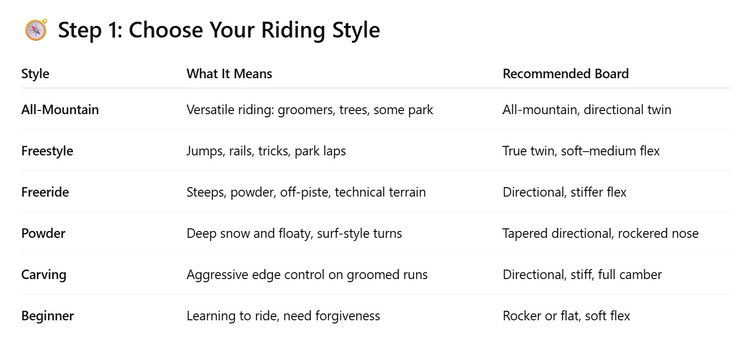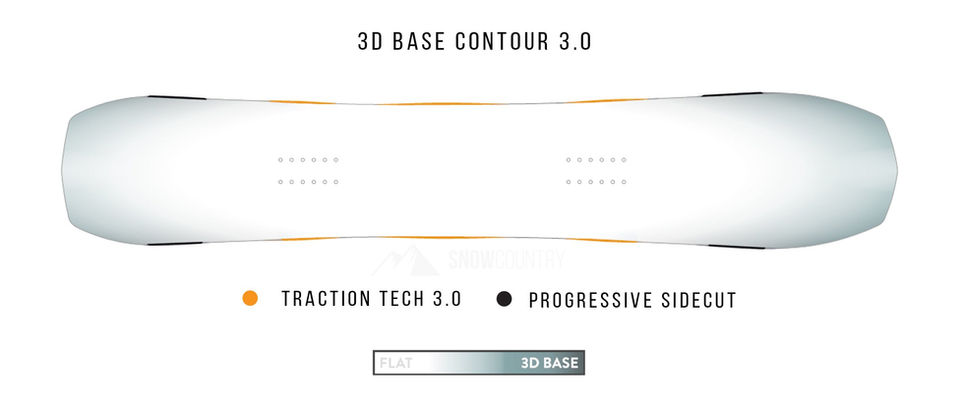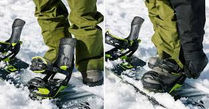
björn snowsport
Snowboard training with style

Snowboard Gear Guide
1. Snowboard Types
Each type is suited to different terrains and styles:



2. Camber & Rocker Profiles (Board Bend)
These influence how the board handles, grips, and turns.


3. Shape Profiles
The shape affects how the board rides in different directions and terrains.


4. Edge Technology
How edge technology impacts grip and ride in snow and ice.


5. Base Variation
3D Base Contouring: Elevate Your Ride with Smoother Turns, Better Float, and Catch-Free Control.


6. Snowboard Buyer’s Guide: Find the Perfect Ride for Your Style
Your Next Board Starts Here: A No-BS Guide to Buying a Snowboard.

Personalized Snowboard Match Form
Please copy and paste, fill out the form below and send it back to ChatGPT for tailored snowboard recommendations.
👤 Rider Profile
-
Name (optional):
-
Age:
-
Height (inches or cm):
-
Weight (lbs or kg):
-
Boot size (US/EU/Mondo/UK):
-
Gender (optional):
🏔️ Riding Experience
-
Experience Level:
(Beginner / Intermediate / Advanced / Expert) -
Years Snowboarding:
🏂 Riding Style (Delete or Add)
-
All-Mountain
-
Freestyle / Park
-
Freeride / Backcountry
-
Powder
-
Carving
-
Just Learning
🌍 Typical Conditions & Terrain
-
Where do you usually ride? (e.g., East Coast, Rockies, Alps)
-
Common conditions:
(e.g., hardpack, ice, powder, slush)
🎯 Riding Goals (Delete or Add)
-
Improve turns/carving
-
Ride more powder
-
Learn tricks/jumps
-
Explore off-piste/backcountry
-
Get more stable at high speed
-
Need something playful and forgiving
🛠️ Preferences (Optional)
-
Preferred flex: (Soft / Medium / Stiff / Not sure)
-
Preferred camber type: (Rocker / Camber / Hybrid / Triple Camber / Not sure)
-
Brand preferences:
-
Board graphic/style preferences (if any):
💬 Anything else I should know?
(Add any notes, injuries, gear you already own, etc.)
6. Final Tip: Try Before You Buy
No matter how much research you do, nothing beats strapping into a board and riding it. Every snowboard has a unique feel—whether it’s the camber profile, edge hold tech, or how the base contouring and 3D shaping rolls through a turn. Even subtle differences in nose shape, tail taper, or sidecut radius can dramatically affect your experience on snow.
That’s why we always recommend: go rent or demo a few boards before committing. Try different shapes (true twin, directional, tapered), play with profiles (camber, rocker, hybrid, triple camber), and pay attention to how various base technologies (like spooned tips, triple base, or beveled edges) feel under your feet. You might discover you love a surf-style board in powder—or that you crave the locked-in feel of full camber for carving.
Lastly, consider your riding style and goals. Are you progressing in the park? Floating through trees? Teaching students? Charging alpine groomers? The right board makes all the difference—and the right board is the one that brings out your best ride.
So explore, test, and most of all—have fun with it. The mountain is your playground. Ride what feels right for you.
7. Online Buyer’s Guide
👀 Looking for More?
Not fully satisfied with our guide? No worries — we've got you covered.
Click any of the images below to explore some of the most trusted snowboard buyer’s guides from around the web.
The Good Ride – Snowboard Gear Buying Guide
-
Offers in-depth, independent reviews and comparisons of snowboards, boots, and bindings.
-
Features a unique scoring system to compare boards within categories.
Whitelines – Best Snowboards for 2024-2025
-
Features a hand-picked selection of top snowboards across various categories.
-
Includes expert reviews and recommendations.

8. Snowboard Bindings Buyer’s Guide
How to Choose the Right Snowboard Bindings
Bindings are the unsung heroes of your setup. They transmit your movements to the board, control response, and can either boost your comfort—or ruin your day. From freestyle tweaks to alpine carves, choosing the right bindings makes all the difference.
Here’s what you need to know before you buy:


👣 3. Fit and Compatibility
-
Boot should sit snugly in the binding—no wiggling, no overhang.
-
Check sizing from the manufacturer (S, M, L, XL, S-M, L-XL)
-
CLEW, Supermatic and FASE™ work with any regular snowboard boot—no boot change required.
-
Burton Step-On need Step-On specific boots
-
K2 Clicker need specific boots to
-
Check mounting compatibility:
-
4x4 or 2x4 inserts = standard
-
Channel system (Burton) = requires EST/Re:Flex
-
✅ Final Thoughts
Your bindings are your connection to the board. If they don’t match your riding style, comfort needs, and daily rhythm—everything else suffers.
Step-in systems like FASE™, Step On, CLEW, Supermatic and Clicker are amazing if you can strap in while standing. If not, start by mastering traditional bindings and go from there.
Try different systems on snow if you can. When the right setup clicks—you’ll know.

9. Snowboard Boots Buyer’s Guide
👢 How to Choose the Right Snowboard Boots
Your boots are the single most important piece of gear. If your feet hurt, your whole day is ruined—no matter how great your board or bindings are.
🧠 Pro Tip: Snowboard boots are the only piece of gear we don’t recommend buying online without trying them on first. A good shop with a knowledgeable boot fitter is worth its weight in powder.
🏪 1. Get Fitted by a Boot Specialist
-
A proper fit isn't just about size—it's about foot shape, ankle hold, heel lift, and arch support.
-
Every brand fits differently. Even the same size can feel wildly different across models.
-
Heat-moldable liners can be custom-formed to your foot.
-
Local boot fitters can tweak pressure points, heat mold your liners, or add footbeds.
✅ If you only visit a shop once, make it for your boots.
📏 2. Sizing & Fit Tips
-
Snowboard boots should feel snug but not painful.
-
Toes should just barely brush the front when standing upright—not curled or cramped.
-
Your heel should stay locked down when flexing forward.
-
Boots pack out slightly over time, so avoid sizing too big.



🧲 5. Boot-to-Binding Compatibility
-
Some step-in systems require specific boots:
-
Burton Step On boots only work with Step On bindings.
-
K2 Clicker boots are needed for Clicker X HB bindings.
-
-
Systems like CLEW, Supermatic, FASE™, and traditional strap-in work with any standard boots.
-
Always check fit inside your actual bindings if possible.
🔁 6. Break-In Period & Comfort
-
Boots feel tight at first but loosen up after 2–5 days of riding.
-
Avoid heat molding at home—let a pro do it if needed.
-
Good socks make a huge difference. Use ski or snowboard specific socks.
🥾 7. Snowboard Boot Brands to Explore
The right boots make all the difference in performance, comfort, and all-day stoke. These are the top brands trusted by pros, instructors, and experienced riders worldwide:
-
Burton
Industry leader with a wide range of fit and flex options. Known for Step On systems and consistent comfort. -
ThirtyTwo (32)
Custom-fit performance with heat-moldable liners. Loved by freestyle and backcountry riders for their feel and durability. -
Salomon
Secure heel hold, balanced flex options, and premium BOA + speed lace tech. Great for all-mountain versatility. -
Vans
Skate-inspired boots with premium comfort and flex. Ideal for freestyle and park riders who want style with substance. -
Ride
Tech-forward boots featuring Michelin outsoles and a responsive, locked-in feel. Solid choice for aggressive riders. -
K2
Known for Clicker X HB step-in compatibility and dependable all-mountain support. Solid out-of-the-box fit. -
Rome
Rider-focused design with great adjustability. A good balance of freestyle flexibility and all-mountain response. -
Nidecker
Swiss design, clean style, and comfort-focused boots—often paired with Supermatic and FASE™ systems. -
Nitro
Strong mid-range boots with comfort, durability, and a great fit. Excellent lace and BOA hybrids. -
DC
Street-inspired style with serious snow performance. Known for their comfort, especially in freestyle applications. -
Deeluxe
Precision-crafted boots with a performance edge. Used by many freeriders and backcountry professionals. -
Northwave
Italian brand known for innovation, comfort, and legendary Speed Lace SL systems. A hidden gem for demanding riders.
❌ Don’t Buy Boots Blindly Online
❗ Even if you know your size and brand, last year’s boot might fit differently. Always try boots on in person—or be sure there’s a no-hassle return policy.
✅ Final Thoughts
-
If you're only going to spend extra time or money on one piece of snowboard gear—make it your boots.
-
Visit a boot fitter, try on multiple brands, and match your boots to your riding style and binding system.
-
A well-fitted boot will feel intuitive, powerful, and all-day comfortable—and your riding will thank you.
10. Helmet Buyer’s Guide
🪖 How to Choose the Right Snowboard Helmet
Whether you're a weekend cruiser or a backcountry charger, a good helmet isn’t optional—it’s essential. But with so many features, fits, and styles, picking the right one can feel overwhelming.
This guide breaks down what really matters so you can ride safe and stay comfortable all season long.
🧠 1. Safety Standards (What to Look For)
-
Look for certification labels: CE EN 1077, ASTM F2040, or MIPS technology.
-
MIPS (Multi-directional Impact Protection System) adds protection against rotational forces.
-
Dual-certified helmets work for both skiing and snowboarding.
-
🎯 2. Fit is Everything
-
Your helmet should feel snug but not tight.
-
Use the brand’s sizing chart (usually based on head circumference in cm).
-
Most helmets offer:
-
Dial-fit systems for adjustability
-
Padded liners for comfort and warmth
-
Removable ear pads for fine-tuning fit and airflow
-
🧵 Pro Tip: Try it on with your goggles to ensure there's no gap between goggle and helmet ("gaper gap").
💨 3. Ventilation Matters
-
Choose between:
-
Fixed vents (lighter, simpler)
-
Adjustable vents (better for changing conditions)
-
-
If you ride in varied weather or work up a sweat teaching/riding, adjustable is a smart choice.
🎧 4. Extra Features Worth Considering
-
Audio-compatible ear pads
-
Goggle clips or magnetic goggle integration
-
Lightweight in-mold construction for low-profile feel
-
Visor-style or brimmed helmets for extra sun/snow protection

Top 10 Snowboard Helmet Brands to Know
Not all helmets are created equal. Whether you prioritize fit, style, safety, or performance, these brands consistently deliver quality and innovation.
Smith
-
Known for: Premium materials, Koroyd® impact tech, MIPS, seamless goggle integration
-
Best for: All-mountain and freeride riders who value performance + ventilation
-
Top models: Vantage, Level, Mission
Giro
-
Known for: Reliable fit systems, wide size range, excellent value
-
Best for: Beginners to advanced riders looking for consistent comfort and safety
-
Top models: Range MIPS, Ledge, Emerge
Oakley
-
Known for: Seamless goggle integration, clean aesthetic, BOA fit + MIPS
-
Best for: Riders using Oakley goggles or who want sleek, high-performance protection
-
Top models: MOD1 Pro, MOD5 MIPS, MOD7 Visor
Bern
-
Known for: Skate-style, low-profile, multi-season helmets
-
Best for: Freestyle riders, park rats, instructors, or crossover use (snow + bike)
-
Top models: Watts 2.0 MIPS, Macon 2.0, Hendrix
POC
-
Known for: Scandinavian design, exceptional safety, tech-forward build
-
Best for: Serious freeriders, racers, and safety-conscious parents
-
Top models: Obex SPIN, Auric Cut BC, Fornix
Anon (by Burton)
-
Known for: Clean design, magnetic goggle integration (MFI), MIPS
-
Best for: Riders who want seamless helmet + goggle setup and modern styling
-
Top models: Merak, Echo, Rodan
Salomon
-
Known for: Lightweight performance, excellent fit
-
Best for: All-mountain and touring riders who value comfort over flash
-
Top models: Husk Pro, Driver Visor, MTN Lab
Sweet Protection
-
Known for: Extreme durability, low weight, high-end race tech
-
Best for: Advanced riders, racers, and backcountry chargers
-
Top models: Switcher MIPS, Igniter II, Trooper II
Sandbox
-
Known for: Freestyle-friendly, low-profile skate style
-
Best for: Park and street riders who prioritize looks with reliable protection
-
Top models: Legend, Classic 2.0 Snow, Icon
Pret
-
Known for: Lightweight builds, great ventilation, adaptive fit systems
-
Best for: Riders who value comfort, function, and subtle styling
-
Top models: Fury X, Refuge X, Cynic X
Note: Also worth checking out are newer or niche brands like Ruroc (futuristic full-face systems) and Anti Ordinary A2 (minimalist freestyle helmets from Korea). These aren't always in the top 10 for global popularity, but they offer standout features for specific riders.
🔚 Final Thoughts
Your helmet isn’t just safety gear—it’s your all-day companion.
Invest in something that fits well, feels great, and meets modern safety standards.
Try it on with your goggles and test the fit before heading to the mountain.



11. Goggle Buyer’s Guide
🥽 How to Choose the Right Snow Goggles
Whether you're carving groomers, floating through powder, or teaching on a stormy day, good goggles make a huge difference. They protect your eyes, improve visibility, and keep your riding experience safe and comfortable.
Here’s everything you need to know when buying snowboarding goggles:

🔄 3. Lens Change Systems
-
Magnetic lenses – Fastest (Anon, Oakley, Glade)
-
Click-in systems – Secure, intuitive (Smith I/O series)
-
Traditional frame pop-outs – Reliable but slower
🎿 If you ride in changing light, invest in goggles with a quick-change lens system.
💨 4. Ventilation & Anti-Fog
-
Double-layer lenses help prevent fog buildup.
-
Look for anti-fog coatings and ventilation foam at the top/bottom of the frame.
-
Avoid blocking vents with helmets or facemasks.
🧠 5. Fit & Compatibility
-
Match goggles with your helmet—brands like Smith, Oakley, and Anon are designed to integrate smoothly.
-
Look for triple-layer face foam for comfort and a good seal.
-
Consider Asian Fit models for flatter nose bridges, if needed.
📱 6. Bonus Features to Consider
-
OTG (Over The Glasses) fit for prescription wearers
-
Integrated HUD (Heads-Up Display) for advanced tech goggles
-
Photochromic lenses that adapt to light
-
Goggle + face mask magnet integration (e.g., Anon MFI)
🔝 Trusted Goggle Brands
-
Smith – Known for ChromaPop™ lenses, I/O series
-
Oakley – Prizm™ tech, sleek design, top-tier optics
-
Anon – Magnetic lenses (M4/M5), seamless MFI facemasks
-
Dragon – LumaLens tech, solid ventilation
-
POC – High safety standards, wide view
-
Giro – Comfortable fit, Zeiss lenses
-
Spy – Budget-friendly with good features
-
Glade – Direct-to-consumer, premium feel at lower price
✅ Final Tips
The best goggles are the ones you forget you're wearing. Prioritize clarity, fit, and ease of lens changes. And if you can—try them on with your helmet before you buy.



12. Gloves Buyer’s Guide
🧤 How to Choose the Right Snowboard Gloves
Your gloves aren’t just for warmth—they’re for protection, convenience, and performance. Whether you're teaching lessons, riding powder, or adjusting gear mid-run, the right gloves make a big difference.


🧊 2. Insulation Levels
-
Thin (Low Insulation): For spring laps or park days.
-
Medium: Versatile and balanced for all conditions.
-
High (Heavy Insulation): Ideal for cold climates and deep winter.
💧 3. Waterproofing & Materials
-
GORE-TEX® – Best-in-class waterproofing.
-
Other Membranes: DK Dry, DryRide, Hipora.
-
Shells: Goat leather (durable), softshell (lightweight), synthetics.




📏 6. Fit, Sizing & Features
-
Fit: Snug, not tight. No pressure points. Try with your jacket.
-
Cuff: Gauntlet for coverage, under-cuff for style.
-
Features to Look For: Wrist leash, touchscreen fingertips, removable liners.
🏆 Top Glove Brands
-
Burton – Full range, great value
-
Dakine – Performance-focused
-
Hestra – Premium durability
-
Level – Built-in wrist guard pros
-
Demon – Serious protection
-
Vallerret – Made for photographers
-
Deathgrip – Innovative splitboarder + instructor gloves
-
POW, Howl, Oyuki – Style meets function
✅ Final Thoughts
Cold fingers and sore wrists ruin days. Invest in gloves that match your riding style, weather, and needs.
Whether you prioritize warmth, wrist safety, or hand freedom—there’s a perfect glove out there.
❄️ Try before you buy when you can, and don’t overlook key features like waterproofing, zippers, and guards that could seriously improve your ride.
13. Snowboard Outerwear Buyer’s Guide
Stay warm. Stay dry. Stay out longer. The right outerwear setup isn’t just about style—it’s about comfort, safety, and performance in changing mountain conditions.




🌬️ 3. Windproofing
-
Hard shells (GORE-TEX®, 3L) offer full windblock.
-
Softshells provide partial wind protection but more stretch/breathability.
-
Windproofing matters most in high alpine, chairlift rides, or exposed terrain.


6. Features to Look For
-
Seam Sealing: Fully taped > critically taped
-
Powder Skirt: Stops snow up the back
-
Vents: Underarm and leg zips release heat
-
Adjustable Hoods: Helmet-compatible for storm days
-
Wrist Gaiters & Snow Cuffs: Keep snow and cold out
-
Recco Reflector: Helps rescuers locate you (found in premium outerwear)
✅ Final Tips
-
If you ride mostly resort, go insulated or a 2L shell with good layers.
-
If you hike, splitboard, or ride deep powder, invest in a 3L shell with high breathability.
-
Layering = control: adapt to changing conditions by removing or adding layers.
-
Don’t forget good socks, gloves, and face protection—they complete the system.

























